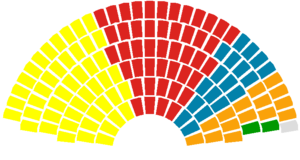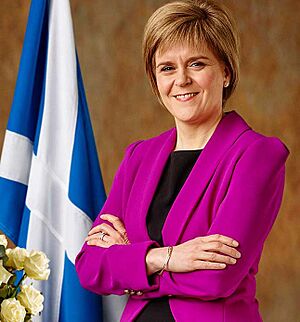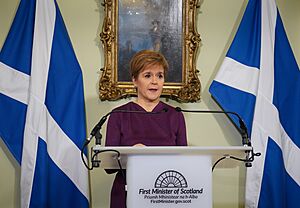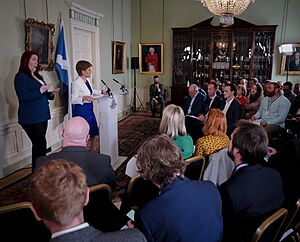History of the Scottish National Party facts for kids
The Scottish National Party (SNP) is a major political party in Scotland. It believes Scotland should be an independent country. The SNP is known for its left-leaning ideas, focusing on social fairness. It has been in charge of Scotland's own parliament, the Scottish Parliament, since 2007. They were a minority government at first, then a majority from 2011, and a minority again since 2016.
Contents
Early Years of the SNP (1934–1960)
The SNP was formed on 7 April 1934. It was created when two groups, the National Party of Scotland and the Scottish Party, joined together. Sir Alexander MacEwen became the first leader. The idea for this merger came from John MacCormick, who wanted all Scottish nationalist groups to work as one.
At first, the SNP didn't fully support Scotland becoming completely independent. Instead, they wanted a Scottish Assembly (a local parliament) within the United Kingdom. This was a compromise between the two original parties. However, the SNP soon changed its mind and decided to push for full independence.
Professor Douglas Young led the SNP from 1942 to 1945. He was known for encouraging Scots to refuse to join the army during World War II. He was even put in prison for this.
John MacCormick left the party in 1942. He wanted the SNP to support "Home Rule" (more power for Scotland, but not full independence), but the party decided to stick with independence. MacCormick then started the Scottish Covenant Association. This group gathered over 2 million signatures for a petition asking for Home Rule.
The SNP didn't win many elections in its early years. In 1945, Robert McIntyre became the first SNP member elected to the UK Parliament. He won a special election during wartime but lost his seat in the general election later that year. The 1950s were tough for the party, with low support and few candidates in elections.
In 1955, a small group of younger members, called the 55 Group, tried to change things within the SNP. This group was mostly in Edinburgh and didn't have a big impact in the long run.
The 1960s: Growing Support
Even though the 1950s were slow, the SNP started to gain more attention in the 1960s. They got a lot of votes in some special elections, like in Glasgow Bridgeton in 1961 and West Lothian in 1962. The party grew quickly, with many new local groups forming. For example, in 1966, 113 new branches were officially recognized.
A big moment came in 1967. The SNP did very well in a special election in Glasgow Pollok, getting 28% of the votes. Later that year, Winnie Ewing won a special election in Hamilton. This made the SNP a serious force in politics. Ewing famously said, "Stop the world, Scotland wants to get on!" Her victory made many Scots feel hopeful and encouraged new people to join the party.
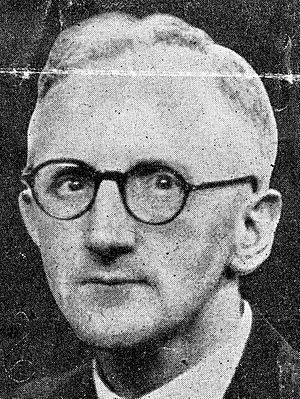
In local elections, the SNP also started to do well. In 1967, they gained 27 seats in town elections and 42 in county elections. They even took control of Stirling council, where former leader Robert McIntyre became the local mayor. In 1968, the SNP won the largest share of votes in Scottish local elections, getting about 40% of the total.
Winnie Ewing's win and the SNP's success in local elections made the UK Labour Government create the Kilbrandon Commission. This group was set up to plan for a Scottish Assembly. It also led Edward Heath of the Conservative Party to promise a Scottish Assembly if he became Prime Minister.
Scottish politicians who wanted Scotland to remain part of the UK became worried about the SNP's growth. The Labour Party was especially concerned because much of their support came from Scotland, and the SNP was now winning votes in their strongholds.
In 1969, William Wolfe was elected as the new SNP leader, taking over from Arthur Donaldson.
The 1970s: Oil and Growth
In the 1970 general election, the SNP got more votes than before, but didn't make a huge breakthrough. Winnie Ewing lost her Hamilton seat. The only good news was that Donald Stewart won the Western Isles seat, making him the SNP's only Member of Parliament (MP). After this, the SNP continued to grow, just like in the 1960s.
A small group of members left the party in the early 1970s to form a new Labour Party of Scotland. This group didn't last long, and most of its members later returned to the SNP.
The SNP got a big boost when Margo MacDonald won the Glasgow Govan seat from the Labour Party in a special election in 1973. This showed Labour again that the SNP was a real threat. In the February 1974 General Election, the SNP won 7 MPs. Because Labour didn't win enough seats to form a majority government, another election was held in October 1974. The SNP did even better, winning 11 MPs and getting over 30% of the votes across Scotland.
A major reason for the SNP's growth in the 1970s was the discovery of oil in the North Sea near Scotland. The SNP ran a very successful campaign called "It's Scotland's oil". They argued that the oil wealth could greatly benefit all of Scotland's people. This idea offered a strong vision for Scotland's future, especially during a time when the British economy was struggling.
Former SNP leader William Wolfe said that the party also gained support by backing workers in important industrial disputes, like the Upper Clyde Shipbuilders Work-in.
1979 General Election and Referendum
The SNP was popular in the opinion polls throughout the 1970s. By 1976, the Labour Government in the UK had lost its majority in Parliament. This meant it needed the SNP's support to stay in power. The SNP asked for "home rule for Scotland" in return.
In 1978, a law was passed to hold a referendum (a public vote) on creating a Scottish Assembly. However, an amendment was added that said the proposal needed to be approved by 40% of *all* registered voters, not just 40% of those who voted. In the referendum, 51.6% of voters said "yes," but because not enough people voted overall, the 40% rule wasn't met. This meant the Scottish Assembly was not created.
Because the referendum failed, the SNP stopped supporting the Labour Government. In 1979, the SNP voted against the Labour Government in a "Vote of No Confidence," which led to a general election. The Labour Prime Minister, James Callaghan, famously said this was like "turkeys voting for Christmas" for the SNP. After the 1979 general election, the SNP only had two seats, losing nine. Margaret Thatcher became the new UK Prime Minister.
Changes After 1979
After the failure of the Scottish Assembly referendum and the poor election result in 1979, the SNP went through a difficult time. There were disagreements within the party. Two internal groups, Siol nan Gaidheal and the left-wing 79 Group, were banned. However, some members of the 79 Group, like Alex Salmond, later became very important in the party. Margo MacDonald left the SNP for a while due to these internal issues, but she later returned.
Another group, the Campaign for Nationalism in Scotland, was formed to focus mainly on independence, rather than left-right political ideas. This was different from the direction William Wolfe had taken the party, making it more social democratic.
The 1980s: Rebuilding and New Ideas
The internal disagreements in the SNP ended at the 1982 party conference, where internal groups were banned. The party was strengthened when Jim Sillars and many other members from the Scottish Labour Party (SLP) joined the SNP. Sillars had been a Labour MP but left to form the SLP in 1976, unhappy with Labour's policies on Scotland. These new members helped strengthen the left-wing side of the SNP.
In 1979, William Wolfe stepped down as leader, and Gordon Wilson was elected to replace him.
The 1980s were still challenging for the SNP, with poor results in the 1983 and 1987 General Elections. Even the party leader, Gordon Wilson, lost his seat in 1987. The party then started to rethink its policies. Jim Sillars became very influential, and the SNP firmly placed itself on the left of the political spectrum.
Sillars argued that the SNP needed to explain how independence would improve people's lives, not just focus on independence itself. He also helped the party adopt the idea of "Independence in Europe," meaning an independent Scotland would remain part of the European Union. Before this, the SNP had been unsure about Europe.
In 1988, the SNP had a big win when Jim Sillars won the Govan seat in a special election for the second time. This was a huge surprise, as the SNP overturned a large Labour majority. Sillars' strong speaking skills and campaigning methods played a key role in this victory.
Sillars' win worried the Labour Party in Scotland, just as Winnie Ewing's win had in the 1960s. Fearing they were losing support in Scotland, Labour helped create the Scottish Constitutional Convention to plan for devolution. The SNP initially considered joining but decided not to because the Convention would not consider full independence as an option.
The 1990s: The Scottish Parliament is Born
The First Salmond Era
In 1990, Gordon Wilson stepped down as leader, and Alex Salmond was elected to replace him. Salmond's win was a surprise to many. He proved to be a very skilled leader, known for his clever and intelligent way of debating, which helped raise the SNP's profile across the country.
In the same year, the SNP gained another MP when Dick Douglas, a Labour MP, joined the SNP. This brought the SNP's number of MPs in Westminster to five.
The 1992 General Election was a mix of good and bad for the SNP. They kept three seats but lost Govan and Dunfermline West. However, their total number of votes went up by 50% compared to 1987. After this election, Jim Sillars left active politics.
Between 1992 and 1997, the SNP had some electoral successes. In the 1994 European Parliament elections, the party won over 30% of the vote and elected two Members of the European Parliament (MEPs), Winnie Ewing and Allan MacCartney. The SNP also came very close to winning a special election in Monklands East in 1994. In 1995, Roseanna Cunningham won the Perth and Kinross by-election, becoming an SNP MP.
In the 1997 General Election, the SNP doubled its number of MPs from three to six.
The Scottish Parliament is Established
When the Labour Party came back to power in the UK, they held a referendum on Scottish devolution. This vote led to the creation of the Scottish Parliament. This new parliament gave the SNP a great chance to become a stronger political force in Scotland. In the first Scottish Parliament election in 1999, the SNP won 35 Members of the Scottish Parliament (MSPs). Later that year, they also sent two members to the European Parliament.
The 2000s: New Leaders and Victories
Swinney's Leadership
In 2000, John Swinney was elected as the new leader, replacing Alex Salmond. Swinney's leadership faced challenges. His calm debating style was often compared to Salmond's more energetic approach.
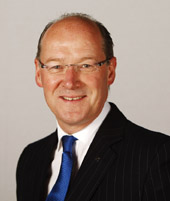
The first term of the Scottish Parliament was difficult for the SNP. Two MSPs, Margo MacDonald and Dorothy-Grace Elder, left the party. The SNP also didn't do well in the 2001 UK general election, losing votes and one MP.
Despite hopes of keeping their number of MSPs, the SNP's support dropped in the 2003 Scottish Parliament Elections. They won 27 MSPs but remained the second-largest party. Only the Scottish Socialist Party and the Scottish Green Party, which also support independence, gained more seats.
In 2003, John Swinney's leadership was challenged by Dr. Bill Wilson. Wilson criticized Swinney for centralizing power and moving the party away from its traditional left-wing position. Swinney won the leadership vote at the party conference.
In 2004, a former candidate started a new pro-independence party, partly because he felt the SNP was too supportive of the European Union. The SNP also suspended an MSP, Campbell Martin, for criticizing Swinney's leadership.
Even though the SNP's vote share dropped in the 2004 European elections, they managed to keep their two MEPs. However, John Swinney announced his resignation on 22 June 2004.
2004 Leadership Contest

After Swinney's resignation, several people announced they would run for leader. In a surprise move, Alex Salmond announced he would also run, even though he had previously said he wouldn't. Nicola Sturgeon then decided to support Salmond and run for Deputy Leader instead.
Salmond and Sturgeon ran on a joint ticket. Salmond was expected to win the leadership easily. There was more uncertainty about who would become Deputy Leader.
On 3 September 2004, Salmond and Sturgeon were elected leader and deputy leader. This was the first time the SNP used a "One Member One Vote" system for its leadership election. Salmond won with 75.8% of the votes, and Sturgeon won with 53.9%.
Since Salmond was an MP in the UK Parliament until 2010, Sturgeon led the party in the Scottish Parliament until Salmond was elected as an MSP in 2007.
2005 UK General Election
The SNP had mixed results in the 2005 general election. They gained two seats, bringing their total to six MPs. Angus MacNeil won in Na h-Eileanan an Iar, and Stewart Hosie won in Dundee East. MacNeil's win was especially praised as it was the first time the SNP gained a seat from Labour in a UK general election in 31 years. However, the SNP's overall share of the Scottish vote fell to 17.7%, and they finished third behind the Liberal Democrats for the first time.
Despite this, Alex Salmond was positive after the election, calling the SNP's MPs "Scotland's Super Six" and promising better results in the 2007 Scottish Parliament election.
The Second Salmond Era
Salmond's return as leader was important for the SNP's ideas. He convinced the party to agree that independence should be achieved through a referendum. This was a big change, as nationalists had previously been wary of referendums. Salmond also shifted the party's economic ideas, aiming to attract international businesses by lowering taxes, similar to the Irish model. While they kept their social democratic message, they moved away from older ideas like nationalization.
2007 Scottish Parliament Election
The SNP won the 2007 election to the Scottish Parliament, becoming the largest party with 47 seats. They narrowly beat the Scottish Labour Party, which had 46 seats. On 16 May 2007, Alex Salmond was elected First Minister by the Parliament. He was the first pro-independence Scottish leader since the Act of Union of 1707.
The SNP's success was helped by voters being tired of Labour, the impact of the 2003 invasion of Iraq, and disagreements within the Labour Party. The creation of the Scottish Parliament also helped the SNP, as it gave them a platform to show they were fighting for Scotland's interests.
The 2010s: Referendum and Landslides
The 2010 UK general election was a bit disappointing for the SNP. They kept their six seats but didn't gain any new ones. However, they did become the second-largest party in Scotland based on total votes.
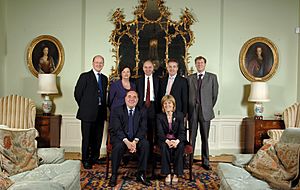
Majority Government in Holyrood
The 2011 Scottish Parliament election was a huge success for the SNP. They won a landslide of 69 seats, forming the first majority government in the Scottish Parliament. This was remarkable because the voting system used was designed to prevent one party from winning a majority. After this victory, the leaders of the other main parties resigned. The SNP then confirmed its plan to hold a referendum on Scottish independence.
Independence Referendum Campaign
In October 2012, the SNP decided to support an independent Scotland remaining a member of NATO. This settled a long-running debate within the party. Two MSPs left the party because of this decision.
In November 2013, the Scottish Government published Scotland's Future, a detailed plan for an independent Scotland. The SNP hoped this document would greatly increase support for independence.
The referendum was held on Thursday 18 September 2014. The "Yes" campaign, which supported independence, was defeated. 44.7% of voters voted "Yes," and 55.3% voted "No." The turnout was very high at 84.6%.
Sturgeon's Leadership
After the independence referendum was defeated, Alex Salmond announced he would step down as SNP leader and First Minister.
On 14 November 2014, Nicola Sturgeon was elected as the new leader of the SNP without anyone opposing her. Stewart Hosie was elected as Deputy Leader. On 20 November 2014, Sturgeon became the First Minister of Scotland, the first woman to hold this position. She then went on a tour of Scotland, speaking to many people.

The SNP's membership grew hugely after the referendum, from about 25,000 members on the day of the vote to around 92,000 by November 2014.
2015 SNP Landslide
The SNP bounced back strongly from the referendum loss in the 2015 UK general election, led by Nicola Sturgeon. The party went from holding six seats in the UK Parliament to 56. They won almost all of Scotland's 59 constituencies, in their biggest ever election victory at any level.
2016 Parliamentary Elections
The SNP remained in charge of the Scottish Parliament after the 2016 Scottish Parliament election. However, they lost their majority, winning 63 seats compared to 69 in 2011. Nicola Sturgeon continued as First Minister, leading an SNP minority government.
2016 EU Referendum
The SNP was the only party to oppose the law that allowed a referendum on the UK's membership of the European Union. While the SNP had campaigned against joining the European Community in 1975, they campaigned to "Remain" in the 2016 referendum. Scotland voted overwhelmingly to remain in the EU, with 62% voting "Remain," while the UK as a whole voted to "Leave." The SNP had stated that if Scotland was taken out of the EU against its will, it would justify another independence referendum. This desire to stay in the EU has been a key reason for the SNP's continued campaign for another independence vote.
2017 UK General Election
In the 2017 United Kingdom general election, the SNP lost 21 seats, bringing their number of MPs down to 35. This was largely linked to their stance on holding a second independence referendum. Many seats were gained by the Conservative, Labour, and Liberal Democrat parties. High-profile losses included former SNP leader and First Minister Alex Salmond.
2019 UK General Election
The SNP had its best ever result in the final European Parliament election before Brexit, winning 3 MEPs, which was half of Scotland's seats. Later that year, the SNP saw a big increase in support in the 2019 general election. They won 45.0% of the vote in Scotland and ended up with 48 out of 59 seats, or 81% of Scotland's seats in the UK Parliament.
The 2020s
2021 Scottish Parliament Election
At the 2021 Scottish election, the SNP won 64 seats, just one short of a majority. They achieved a record number of votes and constituency seats, leading to another minority government led by the SNP. Nicola Sturgeon said her party would focus on managing the COVID-19 pandemic and pushing for a second independence referendum.
Even though they won a minority in 2021, most MSPs elected were from parties that supported Scottish independence. This led to talks between the SNP and the Scottish Green Party to form a deal. This deal meant Green ministers would join the government, and the Scottish Greens would support SNP policies. This united front on independence aimed to strengthen the SNP's case for a second independence referendum. The Third Sturgeon government was formed with Green support.
In the 2022 Scottish local elections, the SNP remained the biggest party, winning a record number of local councillors and gaining majority control of Dundee council.
On 15 February 2023, Nicola Sturgeon announced her decision to resign as leader and First Minister.
On 16 March 2023, it was announced that the SNP's membership had fallen to 72,000, down from over 125,000 at the end of 2019. The party's CEO, Peter Murrell, resigned on 18 March after criticism about how these figures were released.
Post Sturgeon Era (2023 onwards)
Humza Yousaf was announced as the next leader of the SNP on 27 March 2023, after winning the leadership election. Yousaf defeated Kate Forbes in the final round. The leadership election focused on the strategy for a second independence referendum. Yousaf's views are similar to the party's existing leadership, and he is expected to continue Sturgeon's policies.





